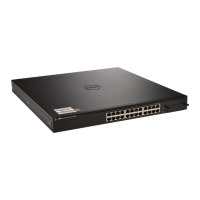32 Introduction
IPv6 Routing Features
IPv6 6 to 4 Auto Tunnels
Automatically formed IPv4 6 to 4 tunnels for carrying IPv6 traffic. The automatic tunnel IPv4
destination address is derived from the 6 to 4 IPv6 address of the tunnel nexthop. There is support the
functionality of a 6 to 4 border router that connects a 6 to 4 site to a 6 to 4 domain. It sends/receives
tunneled traffic from routers in a 6 to 4 domain that includes other 6 to 4 border routers and 6 to 4 relay
routers.
DHCPv6
DHCPv6 incorporates the notion of the “stateless” server, where DHCPv6 is not used for IP address
assignment to a client, rather it only provides other networking information such as DNS, Network Time
Protocol (NTP), and/or Session Initiation Protocol (SIP) information.
OSPFv3
OSPFv3 provides a routing protocol for IPv6 networking. OSPFv3 is a new routing component based on
the OSPF version 2 component. In dual stack IPv6, you can configure and use both OSPF and OSPFv3
components.
IPv6 Routes
Since IPv4 and IPv6 can coexist on a network, the router on such a network needs to forward both traffic
types. Given this coexistence, the PowerConnect 8024/8024F maintains two routing tables, rto and rto6,
which are both capable of forwarding over the same set of interfaces. IPv6 interfaces are managed in a
manner similar to IPv4 interfaces.
IPv6
IPv6 Route Configuration Enhancements
The route configuration and route preference features have the following changes:
You can configure static reject routes.
The default values for route preferences have changed as follows:
• OSPFv3 Intra — 110
• OSPFv3 Inter — 110
• OSPFv3 External — 110
OSPF Type-1 and OSPF Type-2 routes are now classified as OSPF External routes.

